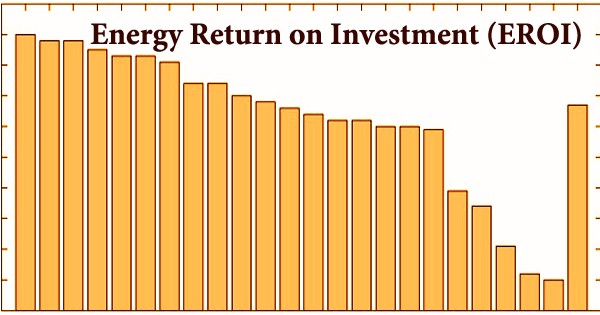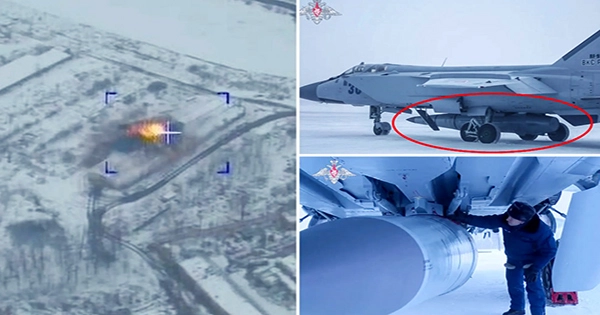Energy return on investment (EROI), also known as energy returned on energy invested (ERoEI), is a ratio that quantifies the quantity of usable energy delivered from an energy source versus the amount of energy used to obtain that energy resource in energy economics and ecological energetics. For example, finding, extracting, delivering, and refining crude oil takes energy before it can be utilized for energy. The energy return on investment (EROI) is a crucial factor of energy prices since energy sources that can be accessed relatively inexpensively allow prices to stay low.
To put it another way, the EROI function compares the cost of an energy plant to the money generated from its sale. The revenue generated must be more than the plant’s cost. When an energy source’s EROI falls below or equals one, it becomes a net “energy sink,” and it can no longer be used as a source of energy. A similar metric to evaluate storage systems, the Energy Stored on Energy Invested (ESOEI) method is utilized. In the pricing of energy commodities and power, the EROI is a critical factor.
Arithmetically the EROI can be defined as:
EROI = Energy Delivered / Energy Required to Deliver that Energy
EROI is crucial because an energy plant is not economically viable if the cost of the plant exceeds the revenue generated from selling power. The energy described in the formula should no longer be used as the major energy source if the total of the EROI formula is equal to or less than one. Instead, it could be put to better use by storing energy (batteries). EROI can also assist businesses and governments in determining which systems are more profitable than others, such as solar or nuclear energy.

To be deemed a viable and economical energy source, it must have an EROI total of at least seven, with a score of seven being a break-even point. A fuel or energy source must have an EROI ratio of at least 3:1 to be regarded feasible as a dominant fuel or energy source. At the point when the EROI is enormous, that implies that delivering energy from that source is moderately simple and financially savvy. Nonetheless, when the number is little, acquiring energy from that source is troublesome and costly.
The EROI function calculates the ratio of inputs to outputs in the energy production process. The inputs and outputs that are gathered to compute EROI are listed below.
- On-site Energy Consumption (Input): Labor energy expenditures, health and safety energy costs, and transportation are all on-site energy consumers.
- Energy Embedded in Materials Used (Input): It encompasses the materials used throughout the building, decommissioning, and operational phases.
- Energy used in Labor (Input): The input calculation includes transportation and energy costs for a full workday for a laborer.
- Heat, Motion, and Electricity (Output): Heat, motion, or electricity are the desirable outcomes of any energy production.
- Environmental Factors (Output): The environment can have a direct impact on energy-generating plants and/or technologies. An earthquake, for example, can knock down a wind turbine or destroy a power plant.
Only human-applied sources are included in the calculation of energy invested, not natural or primary energy sources. However, the way various elements of the input process are measured differs dramatically. This measurement is difficult because the inputs are varied, and it’s unclear how far back they should be included in the study. Nevertheless, the heat of any structure can be tallied where it is really utilized for warming. Be that as it may, the utilization of waste warmth in locale warming and water desalination in cogeneration plants is uncommon, and by and by it is normal avoided in EROI investigation of fuel sources.
Other external expenses linked with energy generation, such as those associated with the environment and people’s health, must be considered in addition to energy costs. The top energy sources are shown here, along with their corresponding energy return on investment scores:
- Nuclear Energy = 75
- Hydro = 35
- Coal = 30
- Closed-Cycle Gas Turbine = 28
- Solar Thermal = 9
- Wind Turbine = 4
- Biomass = 4
- Photovoltaic = 2
The EROI score must be more than seven to be viable. As the list demonstrates, significant energy sources such as wind turbines, biomass, and photovoltaic solar panels are often not cost-effective. When seeking to acquire and utilize a source of energy, a net energy gain is achieved by using less energy. An EROI analysis is a type of life-cycle analysis. Although many characteristics of an energy source matter (for example, oil is energy-dense and transportable, whereas wind is changeable), when the EROI of an economy’s main sources of energy falls, energy becomes more difficult to obtain, and its relative price may rise.
For efficiency and cost analysis, EROI is calculated for a variety of consumable energy sources. Humans have progressively employed exogenous sources of energy to multiply human muscle-power since the birth of agriculture. This has been linked by some historians to more easily exploited (i.e., higher EROI) energy sources, which is related to the concept of energy slaves. Here are the economic implications and effects of EROI:
- Price – As EROI decreases, price increases. It can be shown in photovoltaic solar panels.
- Economic Downturn – According to some experts, an increase in capital intensity and a drop in net energy lead to an economic slump.
- Elasticity – When the EROI is greater than ten, the price-to-EROI connection is relatively steady and linear. When the EROI falls below ten, prices begin to change dramatically.
- Profitability – The EROI score suggests both price limits and profitability.
The average EROI for all generating technologies in the United States, according to the World Nuclear Association, is around 40. The Association cites a study by Weissback et al. (2013), which states that “The results show that nuclear, hydro, coal, and natural gas power systems (in this order) are one order of magnitude more effective than photovoltaics and wind power.” The Energy Return on Investment (EROI) is computed by dividing the energy output by the energy investment. Measuring total energy output is typically simple, especially when it comes to electrical output, which can be measured with an adequate electricity meter.
Researchers disagree, however, on how to precisely calculate energy input, and hence arrive with different quantities for the same source of energy. Over the last century, the EROI for oil has dropped considerably. As more efficient processes, such as fracking, have been implemented, the amount of energy required to produce one barrel of oil has reduced. Another problem with EROI that many studies try to address is that the energy returned might take various forms, each of which has distinct usefulness.
Information Sources:
















